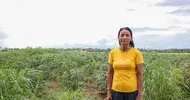ODDO Securities | May 2010
Economic Report
Land grabbing: myth or reality?
- Land grabbing involves purchases or leases of agricultural land on a large scale. This phenomenon, which brings together private investors and governments, has grown rapidly in recent years, especially after the spike in agricultural prices in 2007. Since 2006, an area equivalent to France’s entire farmland is believed to have been subject to land grabbing.
- At the economic level, the two key drivers for land grabbing are, in roughly equal measure, food security and coverage of energy needs (biofuels).
- Foreign investment can be a major source of opportunity for recipient countries by boosting government revenues, transferring technologies and improving the daily lives of the poorest populations. In many regions, particularly in Africa, economic and social development still necessarily entails agricultural development. Added to this, in some emerging or developing countries, there is considerable scope to increase agricultural productivity.
- Even so, numerous ESG risks (Environmental, Social and Governance) are associated with land grabbing. Water stress, deforestation/biodiversity, the risks posed by first-generation biofuels, acceptance by local communities, exposure to the risk of corruption, the respect of fundamental social rights or political instability are just some of the challenges that can be identified.
- Some governance principles are therefore essential to establish a win-win policy: institutional and organisational mechanisms and the involvement of all interested parties, especially local ones, are the key to success. A rich newsflow on land grabbing appears likely in 2010 with announcements of international initiatives and position-taking by key institutions. In this context, it is not impossible that food manufacturers will enter the debate.
- On the basis of our ESG analysis of a panel of 25 countries, three countries subject to land grabbing emerge very positively as a strong opportunity (1) from our evaluation (Australia, Argentina and Brazil), while four countries emerge as a high risk (4): Mozambique, Ethiopia, Pakistan and Sudan.













